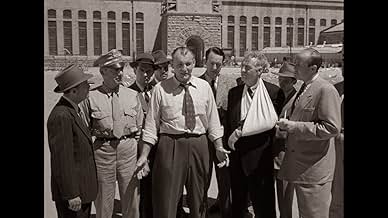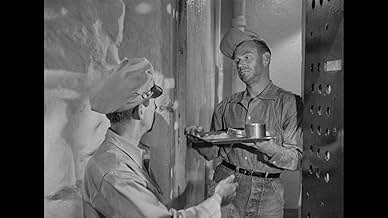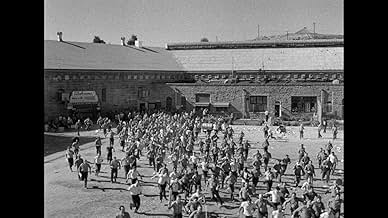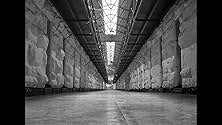अपनी भाषा में प्लॉट जोड़ेंFed up with the inhumane prison living conditions, a general prison riot breaks out, leading to hostage-taking, a stand-off with the guards and eventual negotiations with the prison administ... सभी पढ़ेंFed up with the inhumane prison living conditions, a general prison riot breaks out, leading to hostage-taking, a stand-off with the guards and eventual negotiations with the prison administration officials.Fed up with the inhumane prison living conditions, a general prison riot breaks out, leading to hostage-taking, a stand-off with the guards and eventual negotiations with the prison administration officials.
- 2 BAFTA अवार्ड के लिए नामांकित
- 3 कुल नामांकन
फ़ीचर्ड समीक्षाएं
Cell Block 11 in this particular prison is the solitary ward, the place where the toughest cases are assigned. With a pair like Neville Brand and Leo Gordon in that block would you think otherwise.
Anyway to protest the conditions they're in the prisoners led by Brand stage a riot where they take the guards assigned to that block hostage. When Brand is wounded in a quarrel, Leo Gordon takes over leadership and he's belonging in the psycho ward. But he's the toughest guy in the joint and nobody is going to argue with him.
Emile Meyer does a great job as the warden who is a decent and compassionate individual trying to affect a few reforms. His pleas fall on deaf ears because then as now, convicts don't have any votes and by definition they are an anti-societal group. Meyer's humanity is contrasted with that of Frank Faylen who is a political appointee and tries a grandstand play with the convicts that almost gets him killed.
This is as realistic a prison drama as you will ever get. Big accolades go here to Walter Wanger who had an incredible unique perspective of life on the inside and turned it with Don Siegel's help into a great motion picture.
The storyline starts quickly with a group of prisoners taking their warders hostage and barricading themselves in their cell block. Narrative then follows the proceedings to their conclusion, the action never straying from the prison itself.
Film succeeds mainly as a result of not having any forced characters - none of the prisoners are particularly likable and there are none of the usual dumb characterisations usually found in prison movies. The various authority figures deal with the situation they are presented with in a matter of fact way, and the films stark style remains through to the end.
As I was watching 'Riot in Cell Block 11' I was dreading some wise old sage prisoner coming out of the woodwork, due for parole the following week, who was somehow going to contrive to get himself shot just as the riot was coming to a close, to enjoy a lengthy death scene in someone's arms. Thank goodness nothing like this occurs.
Film made me think of 'Killer's Kiss', in that they are both 1950's low-budget movies with great potential, from a soon-to-be famous director. 'Riot in Cell Block 11' succeeds in all areas, and while its targets may be low it certainly deserves more recognition.
Tho what is known as a "B" movie, and with a budget to match such a programmer, Riot In Cell Block 11 remains today one of the finest entries in the incarceration based genre of film. As relevant today as it was back then, the film has much grit and realism coursing thru its veins. Directed by Don Siegel (Dirty Harry/Escape From Alcatraz), it's written by Richard Collins (uncredited on Invasion Of The Body Snatchers), but it's with producer Walter Wanger that the core of the piece belongs. In 1951 Wanger was convicted of the attempted murder of Jennings Lang. Lang was having an affair with Wanger's wife, and when Wanger caught them in the act, he shot Lang in the groin. Wanger, after copping a plea of temporary insanity, served four months in San Quentin Prison, where his experiences there provided the genesis for Riot in Cell Block 11.
Shot in a semi-documentary style on location at California's Folsom Prison, Siegel and Wanger used actual inmates and guards to authenticate their movie. This was made possible by a certain Sam Peckinpah, who here was doing his first film work as a third assistant director. Legend has it that the Warden of Folsom knew "Bloody Sam's" family and thus allowed the makers into the prison to film. The film also benefits by not having big name stars filling out the cast, Brand & Meyer are joined by Frank Faylen, Leo Gordon, Robert Osterloh, Paul Frees & Whit Bissell. Solid performers to a man, but no headliners, and this helps, as they mix with the real crims and coppers, the realistic feel the makers created.
Siegel's movie isn't looking for simple answers to a persistent problem, it could have easily just gone for a death or glory violent piece of entertainment. But instead it's laced with intelligence and never sinks to preaching, in fact its finale is a rather sombre footnote to the whole episode. The characters are excellently drawn too, and it's good to see that Collins and co don't just make this a cons against authority piece, they clash with each other. Thus hitting home that not all the cons are singing off of the same page. As Warden Reynolds tells when asked about riot leader Dunn, "he's a psychopath, but he's an intelligent psychopath - just like many others on the outside" it's a telling piece of writing. As is the fact that there's no soft soaping either, there's no redemptive love interests or old sage lags to talk common sense into the ring leaders, it's tough uncompromising stuff.
And while we are noting the need for reform, feeling a bond with the prisoners complaints, we are then jolted to not forget that evil men do still reside here. Evil that is perfectly essayed by an excellent Leo Gordon (a real life San Quentin resident) as Crazy Mike Carnie. Watch out for one scene involving a call to a guards wife, the impact is like taking a blow from a claw hammer. You will understand why Siegel said Gordon was the scariest man he ever met.
A top draw movie that doesn't take sides, it has both sides of the fence firmly in its sights. With us the public observing from the middle. 10/10
As far as prison pictures go - This gritty, low-budget, tough-guy tale (though mighty tame by today's standards) still packed a substantial wallop even without a non-stop barrage of profanity and bloodshed.
Filmed (in b&w) on location at Folsom State Prison, California - This particular picture is notable for being one of the first in its genre to have the disgruntled convicts manipulate the media in order to make their grievances about prison conditions known to the public.
Yes. This picture featured typical, prison stereotypes. And, yes, it contained its fair share of unintentional humour, as well - But, all the same - (With its fast-paced, 80-minute running time) - It was still well-worth a view.
"Riot In Cell Block 11" (which was produced on a $300,000 budget) was directed by Don Siegel, who would later go on to direct Clint Eastwood in 1971's Dirty Harry.
If I have a complaint about the movie, it would be that none of the characters are really examined deeply. I would have liked to have learned more about some of the ringleaders of the riot, as well as some of the guards. Though such deeper examinations might have made the movie much longer than the lean yet efficient eighty minute running time, and the movie might have dragged. But that's a minor problem; the movie as a whole works very well.
क्या आपको पता है
- ट्रिवियाLeo Gordon had served five years for armed robbery at San Quentin State Prison. For this reason, Heinze, the Folsom warden, originally objected to Gordon appearing in the film, but director Don Siegel was able to convince him that Gordon was no threat to the prison.
- गूफ़When the state police force the convicts back into the prison by launching a barrage of tear gas at them, the police move forward, into the area being bombarded. The convicts are overcome by the gas, but the police aren't - even though they're not wearing gas masks and are enshrouded by the same gas the convicts are.
- भाव
Warden Reynolds: I promise you no harm will come to you during this conversation. Guard! These are my instructions. Dunn is to be allowed to come into this yard and return to 11 without interference.
- क्रेज़ी क्रेडिटThe following acknowledgment appears after the opening credits: "We wish to thank Mr. Richard A. McGee and his staff of the California Department of Corrections, Warden Heinze, Associate Warden Ryan, Correctional officers and the inmates of Folsom Prison for their co-operation."
टॉप पसंद
- How long is Riot in Cell Block 11?Alexa द्वारा संचालित
विवरण
- रिलीज़ की तारीख़
- कंट्री ऑफ़ ओरिजिन
- भाषा
- इस रूप में भी जाना जाता है
- Terror in Block 11
- फ़िल्माने की जगहें
- उत्पादन कंपनी
- IMDbPro पर और कंपनी क्रेडिट देखें
बॉक्स ऑफ़िस
- बजट
- $2,98,780(अनुमानित)
- चलने की अवधि
- 1 घं 20 मि(80 min)
- रंग
- पक्ष अनुपात
- 1.37 : 1






















